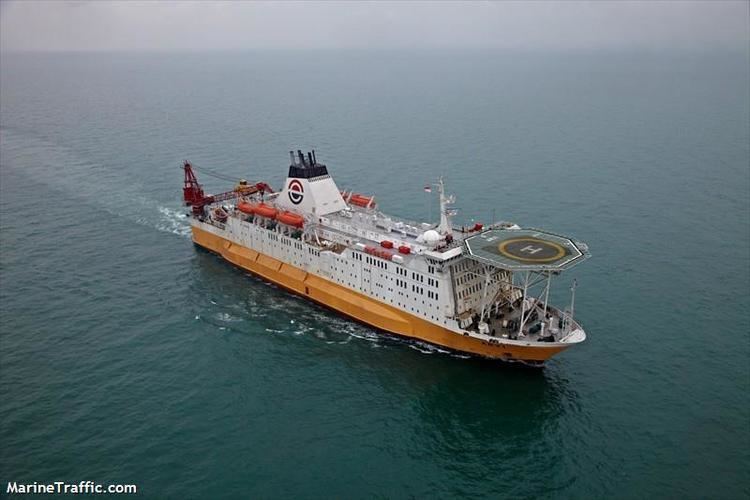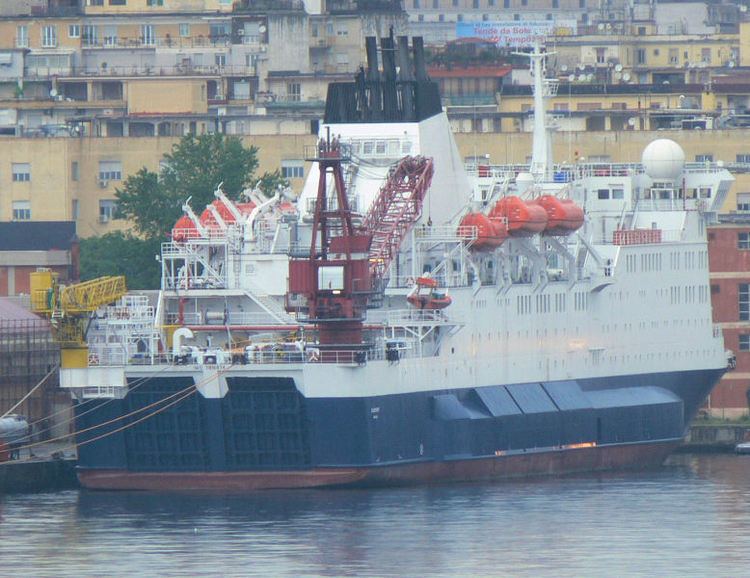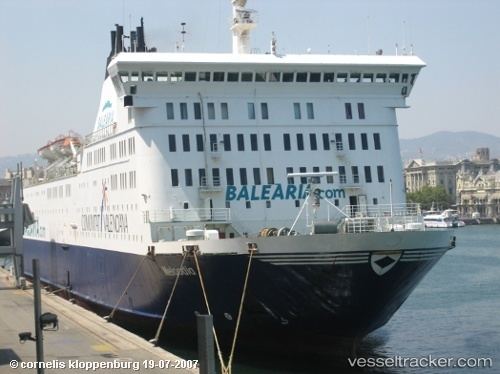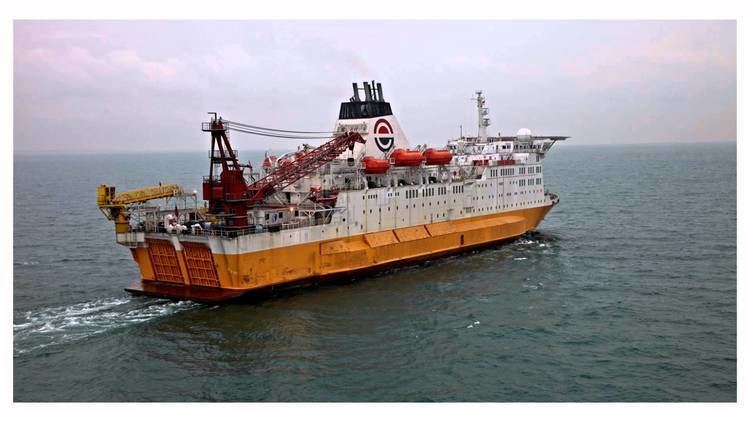Yard number 592 Launched 31 March 1979 Beam 24 m | Acquired 9 June 1979 Length 142 m | |
 | ||
Name 1979 Diana II av Slite1979–1994 Diana II1994 Vironia1994–1996 Mare Balticum1996–2007 Meloodia2007–2013 ARV 12013 onwards Bluefort Owner 1979–1989 Rederi AB Slite1989–1994 PK Finans1994–2002 Nordström & Thulin2002–2007 Tallink2007–2013 Equinox Offshore Accommodation2013 onwards Highclere Operator 1979–1992 Rederi AB Slite1992–1994 TR-Line1994–1996 EstLine1996–2006 Tallink2006–2007 Baleària Port of registry 1979–1992 Slite, Sweden1992–1994 Rostock, Germany1994–2007 Tallinn, Estonia2008–2013 Nassau, Bahamas2013 onwards Majuro, Marshall Islands | ||
MS Bluefort is a car/passenger ferry owned by the Cayman Islands-based company Highclere, under conversion into an Accommodation and Repair Vessel thus also known as (ARV). She was built in 1979 by Meyer Werft, Papenburg, Germany as Diana II av Slite for Rederi AB Slite for use in Viking Line's traffic. She has also sailed under the names Diana II, Vironia, Mare Balticum, Meloodia and ARV 1.
Contents
- Tonnage war in the Baltic
- Design and order
- Entry into service
- Sale and charter contracts
- Estonian operations
- New charter contracts and sale
- Rebuildings
- References

Tonnage war in the Baltic

Rederi AB Slite had great success with their first generation of car and passenger ferries servicing between Sweden and Finland and by the late 1970s the growing market demanded larger ships. Slite's first route within the Viking Line marketing company had been that between Kapellskär and Naantali but this route had since been clogged with Viking Line ships and received competition from Silja Line's similar service between Norrtälje and Turku.

As a first step to find new markets, Rederi AB Slite had sold their merely six years old Apollo in 1976 and replaced her with the older Apollo III, making 24-hour cruises between Stockholm and Mariehamn. The company still served the Kapellskär—Naantali route with their other ship, the 1972-built Diana. But with four other Viking Line ships competing for the same cars and passengers on that route, Slite still needed to break new grounds to keep themselves profitable.

In 1974, the two other Viking Line parters started operating the Stockholm—Turku route which proved to be quite profitable. In preparation for the new ten-year agreement of collaboration between the Viking Line partners to be settled in 1980, Slite made the decision to try to push out Rederi Ab Sally from the Stockholm—Turku route with a newbuilding that would outmatch their current ship there, the Viking 4.
Design and order

The new ship was planned together with her contracted builders, Meyer Werft, Papenburg in West Germany. This shipyard had built the Apollo and the Diana for Slite as well as four sister vessels for Rederi Ab Sally. The design greatly resembled the former ships but the newbuilding was larger in every respect. Among the distinguishing differences were the addition of a second car deck as well as a larger number of berths. The new ship was named M/S Diana II af Slite and launching took place on March 31, 1979.
Entry into service

Less than three months after her launch, the ship was delivered to Rederi AB Slite. On June 14, 1979 she was put into Viking Line service between Stockholm and Turku with daytime callings at Mariehamn, replacing the Viking 4. In September the same year, her registered name was shortened to Diana II, although this had been her marketing name since her delivery.
The loss of the prestigious Stockholm—Turku route made Rederi AB Sally to take action. Only three months after the Diana II's entry into service, Sally ordered an even bigger ship at Meyer Werft. This ship was designed from the same plans as the Diana II, but with several changes made, the final result was almost entirely different from her. After a record building time of 8 and a half months, the newbuilding Viking Sally was delivered and replaced the Diana II on the Stockholm-Turku route. Slite had to withdraw their ship and moved her to the Kapellskär-Naantali route. Although she returned on the Stockholm-Turku during the summer of 1982, the Diana II remained on the Kapellskär-Naantali route for the rest of her Viking Line career.
During her time in Viking Line service, the Diana II encountered one serious incident. On February 5th 1989 she touched ground near Kapellskär and started taking in water. Due to her pumping system at the time only operated at half of its capacity, the ship took in a substantial amount of water and partially sunk in the shallow harbour of Kapellskär. She was soon refloated however and was docked for repairs.
Sale and charter contracts
In order to finance their newbuilding Kalypso which had been a victim of the bankruptcy of Wärtsilä Marine, Rederi AB Slite had to sell the Diana II to PK-banken in 1989. The ship was chartered back to Slite and route remained unaltered.
As Slite's finances got worse during 1992 the company was forced to give the ship up altogether and by December 24 that year, the Diana II made her last sailing for Rederi AB Slite and Viking Line. PK-banken chartered her to TT-Line and she started operating under their brand TR-Line's route Trelleborg—Rostock on December 30.
The Diana II operated on her new route until September 1994 when she was sold to Nordström & Thulin and Estonian Shipping Company who renamed her Vironia with the intention of putting her into service within the EstLine service between Stockholm and Tallinn together with her former Viking Line fleet mate Viking Sally, by now known as Estonia.
Estonian operations
Only weeks before the Vironia was due to enter service on her new route, Estonia sank in a storm killing 852 people. The bow visor construction of Estonia, which caused her sinking, was of the same type as that of the Vironia. As a result of the disaster, the Vironia was renamed Mare Balticum to avoid association with the sunken ship due to the similar name ("Viro" means "Estonia" in Finnish). She was docked and rebuilt in Naantali and her bow visor was welded shut. She eventually entered service on Stockholm-Tallinn on November 11, 1994.
Two years later, Nordström & Thulin acquired another former Viking Line vessel, Anna K. She was renamed Regina Baltica and replaced the Mare Balticum in August 1996. The Mare Balticum was chartered to Hansatee shipping OY and was renamed Meloodia. The ship's bow was rebuilt with bow gates and she was put into Tallink service on the Tallinn—Helsinki route on September 20, 1996. The Meloodia's ownership changed to Tallink's in February 2002 but she remained on the same service until New Year's Eve 2006.
New charter contracts and sale
From January to December 2007, the Meloodia was on charter to the Spanish shipping company Baleària on service between the Balearic Islands and Spanish mainland. She operated different routes between Barcelona, Mahón and Palma de Mallorca.
In November 2007 Tallink entered a memorandum agreement to sell the Meloodia, with delivery in December 2007. When the ship was delivered on 7 December 2007, the buyer was revealed to be Equinox Offshore Accommodation Ltd, a Singapore-based company controlled by Norwegian interests. Subsequently the Meloodia was renamed ARV 1. In January 2008 the ARV 1 arrived at SembCorp Marine shipyards, Singapore for conversion into an accommodation and repair vessel, with the planned delivery in the third quarter of 2008.
Rebuildings
A number of alterations to the original design of the Diana II has been made during the years. Already during her first year of Viking Line service, her decks were heavily polluted by soot from the funnel. The funnel received extended smoke pipes but as the problem persisted, the screen on the rear top of the funnel was removed. After another extension of the smoke pipes, the problem was eventually solved but made the ship's exterior appearance rather odd.
The Diana II's large car deck on deck 4 was during the 1980s deemed to be larger than necessary and of its port side was rebuilt with additional cabins. In preparations of her entry into EstLine service in 1994, the ship received its most extensive modification to date. Apart from the sealing of the bow visor a "duck tail" was added at the stern. Also, the ship's funnel was once again rebuilt to sport a more solid look. The bow remained inaccessible until its complete rebuilding prior to the ships entry into the Tallinn—Helsinki service in 1996.
